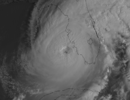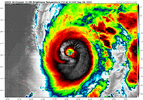-
Hello, please take a minute to check out our awesome content, contributed by the wonderful members of our community. We hope you'll add your own thoughts and opinions by making a free account!
You are using an out of date browser. It may not display this or other websites correctly.
You should upgrade or use an alternative browser.
You should upgrade or use an alternative browser.
Tropical Hurricane Ian
- Thread starter severestorm
- Start date
-
- Tags
- tropical
RollTide18
Member
When I fell asleep this was a Cat 3, I wake up and Ian is almost a Cat 5, unbelievable
Snow_chaser
Member
Lol Brett is on the move, he said screw it, let’s go find some action.
severestorm
Member
NCSNOW
Member
- Joined
- Dec 2, 2016
- Messages
- 9,582
- Reaction score
- 19,103
Anyone watching any live chaser feeds?
Lots consistency on these plots now
In the back of my mind yesterday I was thinking 50/50 shot Ian hits 150mph at his peak so the fact that it’s 155mph and possibly still strengthening is astonishing to me. Completely blew past my expectations. This is why I said a few days back intensity forecasts are complex and complicated to nail down.When I fell asleep this was a Cat 3, I wake up and Ian is almost a Cat 5, unbelievable
Brick Tamland
Member
Anyone watching any live chaser feeds?
Live Storm Chasing
Watch live feeds as storm chasers try to see if their target verifies. Tornadoes, hurricanes, blizzards, and floods - we've got it all and more, live on our site and available as video on demand.
severestorm
Member
That is truly one of the most amazing things to see. I remember the same thing happened with Irma in 2017. Watching how quickly it fills back in as the winds turn is also impressive
DadOfJax
Member
Upwelling may become a real issue for the storms structure if this crawl continues. Also, if it crawls long enough, another ERC could occur right before landfall. These 2 things could be saving graces.
Belle Lechat
Member
- Joined
- Aug 29, 2021
- Messages
- 1,100
- Reaction score
- 847
Time : 122020 UTCTime : 115020 UTC
Lat : 26:01:48 N Lon : 82:45:36 W
CI# /Pressure/ Vmax
6.9 / 922mb / 137kts
Final T# Adj T# Raw T#
6.9 6.8 (-.2) 6.8 (-.2)
Lat : 26:04:11 N Lon : 82:49:11 W
CI# /Pressure/ Vmax
6.9 / 922mb / 137kts
Final T# Adj T# Raw T#
6.9 6.5 (-.3) 6.5 (-.3)
mydoortotheworld
Member
I imagined 140 max as dry air begins to penetrate the core and shear becomes a problem, but as per Twitter (@vortexjeff) Ian’s positioning near the trough was near perfect for continued rapid intensificationIn the back of my mind yesterday I was thinking 50/50 shot Ian hits 150mph at his peak so the fact that it’s 155mph and possibly still strengthening is astonishing to me. Completely blew past my expectations. This is why I said a few days back intensity forecasts are complex and complicated to nail down.
Belle Lechat
Member
- Joined
- Aug 29, 2021
- Messages
- 1,100
- Reaction score
- 847
thundersnow
Member
- Joined
- Dec 17, 2016
- Messages
- 97
- Reaction score
- 185
Only thing about upwelling is… I think that part of the Gulf is relatively shallow? I wonder if it’s even deep enough to pull up enough colder water to make a difference.Upwelling may become a real issue for the storms structure if this crawl continues. Also, if it crawls long enough, another ERC could occur right before landfall. These 2 things could be saving graces.
Bannerdude
Member
DadOfJax
Member
That is a good point. I've always wondered how shallow areas are effected, if at all, by a crawling storm. As the storm crawls, its got to be drastically pulling the warmth from the shallow waters, pulling it into the storm, and dumping much cooler water back in the form of rain. Maybe systems would have to practically sit for hours for this to be an issue?? While its not classic "upwelling" the effect would be the same. Any thoughts?Only thing about upwelling is… I think that part of the Gulf is relatively shallow? I wonder if it’s even deep enough to pull colder water up enough to make a difference.
BHS1975
Member
That is a good point. I've always wondered how shallow areas are effected, if at all, by a crawling storm. As the storm crawls, its got to be drastically pulling the warmth from the shallow waters, pulling it into the storm, and dumping much cooler water back in the form of rain. Maybe systems would have to practically sit for hours for this to be an issue?? While its not classic "upwelling" the effect would be the same. Any thoughts?
I think we saw that with Harvey and Florence.
Sent from my iPhone using Tapatalk


